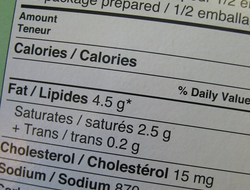Nutrition Fact Labels: The hidden meanings
Published: August 20, 2021
As a savvy consumer you are aware that food manufacturers use references to health to entice you into buying their particular "healthy" food product, but how can you determine which products are "healthy" independently of the manufacturer's claims?
If you're trying to make healthy food choices the nutrition information provided on food packaging can be helpful, but interpreting it can be challenging and time consuming.
Nutrition fact labels/tables that appear on most processed and packaged foods has been standardised for some time.
However,nutrition facts alone may not be enough to determine the "healthiness" of the product.
The ingredient list can supply additional information, but sometimes it seems as if you need a degree in chemistry to decipher the names of some of the ingredients.
Food manufacturers also add their own health facts and health ratings. However, this information may only apply to one ingredient and not the whole product.
For example, a breakfast cereal may have a "low in sugar" decal in a prominent position on the front of the package, but check the nutrition fact label and ingredient list and you may find that the product contains high levels of sodium, and/or trans fats: both of which are nutrients that should be limited.
Assessing the serving size, gram amounts of nutrients, and percent daily value in terms of your daily nutrient requirement maybe even more challenging.
Nutrition facts are provided in terms of a 2000 kcal/day food intake, but maybe you need more or less than 2000 kcal/day.
And what about all the nutrients that are not accounted for on the nutrition fact label?
Many products now sport "ecolabels", but what are these and are they useful to you in making your food choice.
Perhaps it would be easier to avoid processed and packaged foods altogether, but this may not be practical.
How can you optimise the nutrition information that is provided on food packaging so that you can easily identify products which will provide you with the nutrients you need and not the ones that you don't need?
This course will help you interpret nutrition information on food packaging so that you can simplify your healthy food choices. The following topics will be considered:
- How to interpret nutrition fact labels
- Limitations of Health Canada's nutrition fact label
- How to interpret ingredient lists
- How to interpret manufacturer's health checks and health claims
- Applying you knowledge to foods that you purchase
Sign up for this course today and learn how to use nutrition fact tables to help you make healthy food choices. Empower yourself with knowledge.
References
2.
Whitney, E. & Rady Rolfes, S. (2005). Understanding Nutrition. Belmont, CA: Thomson Wadsworth


